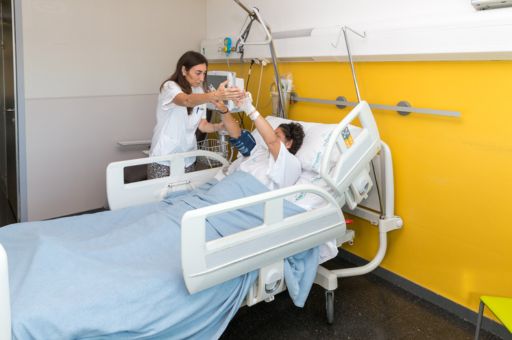Last year, 917 patients with suspected strokes were treated, of which 807 were confirmed
The Hospital Universitario Son Espases has expanded the Stroke Unit with the opening of two new beds, in addition to the current six. From now on, the Stroke Unit has eight beds, distributed in three double rooms and two single rooms. To open these two beds, the Hospital has recruited five nurses and three nursing assistants and has acquired a monitoring system to deal with the disease. Stroke is the leading cause of death among women and the third cause of death among men. It is estimated that one in six people will suffer a stroke in their lifetime.
TDB keeps you informed. Follow us on Facebook, Twitter and Instagram
Son Espases expands the Stroke Unit with two new beds
In recent years, both the number of stroke codes and the number of admissions have increased due to multiple factors, such as the ageing of the population, poorer control of risk factors, especially in the wake of the COVID-19 pandemic, but also to better detection and the increase in reperfusion treatments in the acute phase, derived from new scientific evidence that allows the therapeutic window to be widened.
The increase in resources at the Stroke Unit is included in the Balearic Islands Stroke Strategy, to offer optimal and flexible care according to demand, and responds to an increase in the number of patients suspected of having a stroke or who have suffered a stroke. In the last two years, neurology professionals at Son Espases have seen 40% more patients diagnosed with stroke. Thus, in 2021 they attended 618 suspected cases, of which 561 were confirmed. In 2023 there were 917 suspicions and 804 were confirmed.
A stroke unit is a semi-critical patient unit for people who have suffered a stroke, where the professionals are experts in cerebrovascular diseases. In these units, patients are monitored non-invasively and general care and specific treatment protocols are applied. Stroke patients who are admitted to a stroke unit are more likely to survive and become independent one year after their stroke.
Moreover, care in a stroke unit also improves quality of care indicators: average hospital stay, hospital readmissions, mortality and the need for institutionalisation, while reducing economic costs.
How to detect a stroke?
Loss of strength in half of the body, loss of vision in one eye or difficulty in speaking and understanding are the main symptoms of stroke. In the event of any of these symptoms, it is important to call 061, which is prepared to attend to these cases and transfer the patient to a hospital. If the patient is notified in time for fibrinolytic treatment, the stroke code is activated, which alerts not only the 061 professionals but also the hospital emergency services, the neurologist on duty and all the professionals involved in the diagnosis and treatment process. In the case of an ischaemic stroke, this may consist of medical treatment fibrinolysis endovascular treatment or mechanical thrombectomy.
What can be done to prevent a stroke?
Although stroke occurs suddenly, in most cases there are risk factors: age, sex and family history are factors that cannot be modified, but there are others that should be controlled and modified to reduce the risk and prevent stroke, such as maintaining a rich and healthy diet, low in salt and fat.
Other tips to prevent stroke include the following:
Do not smoke or use drugs.
Do not drink alcohol in excess: at most one glass of wine every day.
Eat a healthy, balanced diet: fruit, vegetables, legumes, fish and virgin olive oil. Five portions of fruit and vegetables are recommended every day.
Take moderate exercise: 30 minutes a day. Walking is healthy and economical.
Control excess weight.
Reduce stress: dedicate a few hours a week to relaxing and satisfying activities.
Plan blood pressure, cholesterol and blood sugar checks with your primary health care provider.
